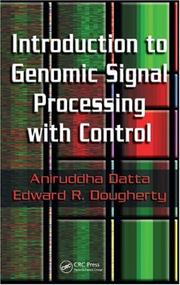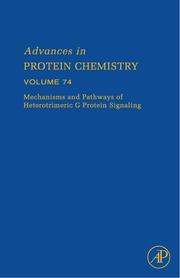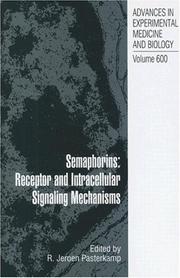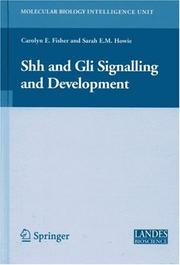| Listing 1 - 9 of 9 |
Sort by
|

ISBN: 0849371988 9780849371981 Year: 2007 Publisher: Boca Raton: CRC,
Abstract | Keywords | Export | Availability | Bookmark
 Loading...
Loading...Choose an application
- Reference Manager
- EndNote
- RefWorks (Direct export to RefWorks)
Cellular signal transduction --- Genetic regulation --- Control theory --- Gene Expression Regulation --- Genomics --- Models, Theoretical --- Signal Transduction

ISBN: 1280832606 9786610832606 1597452009 1588296776 Year: 2007 Publisher: Totowa, N.J. : Humana Press,
Abstract | Keywords | Export | Availability | Bookmark
 Loading...
Loading...Choose an application
- Reference Manager
- EndNote
- RefWorks (Direct export to RefWorks)
Apoptosis, Cell Signaling, and Human Diseases: Molecular Mechanisms, Volumes 1 and 2, present a concise synthesis of recent developments in the understanding of both cell survival and apoptotic pathways. Particular attention is given to apoptosis in human diseases, such as different forms of cancer and neurodegenerative diseases. These comprehensive volumes integrate the most innovative and current findings from several related disciplines of scientific research, including pathology, genetics, virology, cell biology, immunology, and molecular biology. Volume 1 is divided into two sections: “Malignant Transformation and Metastasis” and “Molecular Basis of Disease Therapy.” Volume 2 follows a similar structure and is divided into sections entitled “Kinases and Phosphate” and “Molecular Basis of Cell Death.” All of the contributors are at the forefront of scientific discovery, and the reviews they present systemically examine the most exciting and innovative aspects of their particular areas of expertise. Researchers will find these volumes of major benefit as they search for novel and more effective treatments for human diseases.
Apoptosis. --- Pathology, Molecular. --- Cellular signal transduction. --- Cellular information transduction --- Information transduction, Cellular --- Signal transduction, Cellular --- Bioenergetics --- Cellular control mechanisms --- Information theory in biology --- Molecular pathology --- Molecular biology --- Physiology, Pathological --- Cell death

ISBN: 1280832592 9786610832590 1597451991 1588298825 Year: 2007 Publisher: Totowa, N.J. : Humana Press,
Abstract | Keywords | Export | Availability | Bookmark
 Loading...
Loading...Choose an application
- Reference Manager
- EndNote
- RefWorks (Direct export to RefWorks)
Apoptosis, Cell Signaling, and Human Diseases: Molecular Mechanisms, Volumes 1 & 2, present a concise synthesis of recent developments in the understanding of both cell survival and apoptotic pathways. Particular attention is given to apoptosis in human diseases, such as different forms of cancer and neurodegenerative diseases. These comprehensive volumes integrate the most innovative and current findings from several related disciplines of scientific research, including pathology, genetics, virology, cell biology, immunology, and molecular biology. Volume 1 is divided into two sections: "Malignant Transformation and Metastasis" and "Molecular Basis of Disease Therapy." Volume 2 follows a similar structure and is divided into sections entitled "Kinases and Phosphate" and "Molecular Basis of Cell Death." All of the contributors are at the forefront of scientific discovery, and the reviews they present systemically examine the most exciting and innovative aspects of their particular areas of expertise. Researchers will find these volumes of major benefit as they search for novel and more effective treatments for human diseases.
Apoptosis. --- Pathology, Molecular. --- Cellular signal transduction. --- Cellular information transduction --- Information transduction, Cellular --- Signal transduction, Cellular --- Bioenergetics --- Cellular control mechanisms --- Information theory in biology --- Molecular pathology --- Molecular biology --- Physiology, Pathological --- Cell death

ISBN: 1281072532 9786611072537 0080552692 012034288X 9780120342884 9780080552699 Year: 2007 Publisher: Amsterdam : Academic Press,
Abstract | Keywords | Export | Availability | Bookmark
 Loading...
Loading...Choose an application
- Reference Manager
- EndNote
- RefWorks (Direct export to RefWorks)
G proteins. --- Cellular signal transduction. --- Cellular information transduction --- Information transduction, Cellular --- Signal transduction, Cellular --- Bioenergetics --- Cellular control mechanisms --- Information theory in biology --- GTP-binding proteins --- GTP regulatory proteins --- Guanine nucleotide-binding proteins --- Guanine nucleotide regulatory proteins --- Membrane proteins

ISBN: 1281512931 9786611512934 0387399615 0387399607 Year: 2007 Publisher: New York, NY : Springer New York : Imprint: Springer,
Abstract | Keywords | Export | Availability | Bookmark
 Loading...
Loading...Choose an application
- Reference Manager
- EndNote
- RefWorks (Direct export to RefWorks)
Exocytosis is a fundamental cellular process that is used by eukaryotic cells to release a variety of biological compounds including peptide hormones and neurotransmitters or to insert specific lipids and proteins in the plasma membrane. In recent years, a multidisciplinary approach promoted an extraordinary progress in the understanding of the molecular mechanisms regulating exocytosis. This led to the discovery of a large number of components belonging to the machinery that governs the fusion of secretory vesicles with plasma membranes in different cell systems, including neuronal and endocrine cells. The basic machinery required for vesicle fusion turned out to be well conserved through evolution from yeast to man. So far, because of the large number of components involved, understanding of the molecular basis of exocytosis has remained the privilege of a relatively small group of specialists. This book, written by recognized experts in the field aims at clarifying for a non-specialist audience the role of the key players in the exocytotic process not only in neuronal and endocrine cells but also in a variety of other relevant cell systems. The book represents a unique collection of up-to-date reviews that will introduce researchers and students to the forefront of this rapidly moving and fascinating field.
Exocytosis. --- Cellular signal transduction. --- Cellular information transduction --- Information transduction, Cellular --- Signal transduction, Cellular --- Bioenergetics --- Cellular control mechanisms --- Information theory in biology --- Reverse pinocytosis --- Cell physiology --- Cytology. --- Neurobiology. --- Neurosciences. --- Cell Biology. --- Neurosciences --- Cell biology --- Cellular biology --- Biology --- Cells --- Cytologists --- Neural sciences --- Neurological sciences --- Neuroscience --- Medical sciences --- Nervous system --- Cell biology.

ISBN: 128113953X 9786611139537 0387709568 038770955X 1441924272 Year: 2007 Publisher: New York : Austin, Tex. : Springer Science+Business Media ; Landes Bioscience,
Abstract | Keywords | Export | Availability | Bookmark
 Loading...
Loading...Choose an application
- Reference Manager
- EndNote
- RefWorks (Direct export to RefWorks)
The book summarizes our progress in understanding the receptor and intracellular signaling mechanisms utilized by a family of proteins called the semaphorins. Originally these protein were identified as ""axon guidance cues"" important for the formation of nerve tracts but now it is realized that semaphorins subserve several distinct functions in a multitude of organ systems. The purpose of this book is to summarize our knowledge and make it available as a useful and comprehensive tool for the scientific community. This book will both be interesting for people working in the field as well as c
Semaphorins. --- Cell receptors. --- Cellular signal transduction. --- Cellular information transduction --- Information transduction, Cellular --- Signal transduction, Cellular --- Bioenergetics --- Cellular control mechanisms --- Information theory in biology --- Cell membrane receptors --- Cell surface receptors --- Receptors, Cell --- Binding sites (Biochemistry) --- Cell membranes --- Proteins --- Semaphorin --- Carrier proteins --- Neurosciences. --- Oncology. --- Immunology. --- Cancer Research. --- Immunobiology --- Life sciences --- Serology --- Neural sciences --- Neurological sciences --- Neuroscience --- Medical sciences --- Nervous system --- Tumors --- Cancer research. --- Cancer research

ISSN: 00766879 ISBN: 9780123813473 9780123738516 9780123738523 0123738512 0123738520 9786611028817 1281028819 0080549462 9786611119096 1281119091 0080548717 0123813476 0123813484 128302036X 9786613020369 Year: 2007 Volume: 422-423-471 Publisher: Amsterdam : Academic Press,
Abstract | Keywords | Export | Availability | Bookmark
 Loading...
Loading...Choose an application
- Reference Manager
- EndNote
- RefWorks (Direct export to RefWorks)
Multicellular organisms must be able to adapt to cellular events to accommodate prevailing conditions. Sensory-response circuits operate by making use of a phosphorylation control mechanism known as the ""two-component system."" Sections include: Computational Analyses of Sequences and Sequence Alignments Biochemical and Genetic Assays of Individual Components of Signaling Systems Physiological Assays and Readouts* Presents detailed protocols * Includes troubleshooting tips
Cellular signal transduction. --- Chemotaxis. --- Signal Transduction. --- Enzymology. --- Phosphoproteins -- Physiological effect. --- Protein kinases. --- Human Anatomy & Physiology --- Health & Biological Sciences --- Animal Biochemistry --- Chemiotaxis --- Chemotropism --- Cellular information transduction --- Information transduction, Cellular --- Signal transduction, Cellular --- Biochemistry --- Growth --- Taxes (Biology) --- Bioenergetics --- Cellular control mechanisms --- Information theory in biology

ISBN: 1281140651 9786611140656 0387706305 0387706291 1441924205 Year: 2007 Publisher: New York : Austin, Tex. : Springer Science+Business Media ; Landes Bioscience,
Abstract | Keywords | Export | Availability | Bookmark
 Loading...
Loading...Choose an application
- Reference Manager
- EndNote
- RefWorks (Direct export to RefWorks)
It has been established that TNF receptor associated factors (TRAFs) are critical signaling mediators for not only the TNF receptor superfamily, but also the interleukin-1 receptor/Toll-like receptor superfamily and the T-cell receptors. They play important roles in mammalian biology including embryonic development, innate and adaptive immune regulation and maintenance of cellular homeostasis. Agents that manipulate the signaling of these receptors are being used or showing promise towards the treatment and prevention of many human diseases such as rheumatoid arthritis, coronary heart disease, transplantation rejection, insulin resistance, multiple organ failure and cancer. TNF Receptor Associated Factors is the only literature that is entirely devoted to TRAFs. Almost every aspect of TRAF signaling is covered, including the different TRAF family members, their distinct biological functions, the TRAF structures, their modes of receptor recognition, the signaling mechanisms, and the roles of TRAFs in normal cellular functions and in viral infection. TNF Receptor Associated Factors is intended for a wide audience, including researchers in the field of TRAF signaling and students and postdoctoral fellows learning cell biology and cell signal transduction. This exciting new volume is up to date on the most recent advances in TRAF signal transduction.
Tumor necrosis factor --- Cellular signal transduction. --- Receptors. --- Cellular information transduction --- Information transduction, Cellular --- Signal transduction, Cellular --- Bioenergetics --- Cellular control mechanisms --- Information theory in biology --- Cachectin receptors --- Receptors, Tumor necrosis factor --- TNF receptors --- TNFRs (Tumor necrosis factor receptors) --- Tumor necrosis factor receptors --- Cell receptors --- Death receptors --- Cytology. --- Developmental biology. --- Computer security. --- Cell Biology. --- Developmental Biology. --- Systems and Data Security. --- Computer privacy --- Computer system security --- Computer systems --- Computers --- Cyber security --- Cybersecurity --- Electronic digital computers --- Protection of computer systems --- Security of computer systems --- Data protection --- Security systems --- Hacking --- Development (Biology) --- Biology --- Growth --- Ontogeny --- Cell biology --- Cellular biology --- Cells --- Cytologists --- Protection --- Security measures --- Cell biology.

ISBN: 0387399569 9786611378035 1281378038 0387399577 Year: 2007 Publisher: New York, NY : Springer New York : Imprint: Springer,
Abstract | Keywords | Export | Availability | Bookmark
 Loading...
Loading...Choose an application
- Reference Manager
- EndNote
- RefWorks (Direct export to RefWorks)
he hedgehog signalling pathway is highly conserved and seen in organisms ranging from Drosophila to humans. This pathway is Tcritical in determining cell fate decisions in a variety of different cell types. There are several vertebrate analogues of the Drosophila hedgehog protein of which the most widely studied is Sonic hedgehog (Shh). Shh signalling classically involves the Gli family of zinc-fmger transcription factors. The Shh signalling pathway is well characterised in the develop ment of a number of vertebrate organ systems. It could indeed be argued that the Shh and Gli signalling may well be involved at some stage in the development of all the major organ systems in vertebrates. This volume rep resents a concerted drive to bring together *state of the art' reviews by lead ing experts in the field of Shh and Gli signalling in development from all over the world. The chapters span vertebrate organisms from zebrafish to humans and cover development of the multiple organ systems in which the Shh signalling pathway is crucial for normal development. There are chap ters on the development of the central nervous system, skeletal struc tures, visceral organs, prostate, lung, immune system and the structures of the human face. The authors themselves span three major continents and multiple nationalities which admirably illustrates the worldwide nature of the science.
Cellular signal transduction. --- Developmental genetics. --- Embryonic Induction. --- Embryonic Induction - physiology. --- Morphogenesis - Molecular aspects. --- Morphogenesis. --- Organogenesis. --- Organogenesis - physiology. --- Signal Transduction. --- Signal Transduction - physiology. --- Transcription factors. --- Transcription Factors - genetics. --- Morphogenesis --- Transcription factors --- Cellular signal transduction --- Developmental genetics --- Biochemical Processes --- Embryonic and Fetal Development --- Biology --- Cell Communication --- Proteins --- Embryonic Development --- Body Patterning --- Cell Differentiation --- Cell Physiological Processes --- Biological Science Disciplines --- Amino Acids, Peptides, and Proteins --- Chemical Processes --- Reproduction --- Cell Physiological Phenomena --- Natural Science Disciplines --- Biochemical Phenomena --- Growth and Development --- Disciplines and Occupations --- Chemicals and Drugs --- Phenomena and Processes --- Chemical Phenomena --- Reproductive Physiological Processes --- Physiological Processes --- Reproductive Physiological Phenomena --- Reproductive and Urinary Physiological Phenomena --- Physiological Phenomena --- Signal Transduction --- Embryonic Induction --- Organogenesis --- Genetics --- Physiology --- Transcription Factors --- Health & Biological Sciences --- Biophysics --- Molecular aspects --- Cellular information transduction --- Information transduction, Cellular --- Signal transduction, Cellular --- Genetic transcription factors --- Molecular aspects. --- Life sciences. --- Human physiology. --- Cell biology. --- Developmental biology. --- Life Sciences. --- Developmental Biology. --- Cell Biology. --- Human Physiology. --- Development (Biology) --- Growth --- Ontogeny --- Cell biology --- Cellular biology --- Cells --- Cytologists --- Human biology --- Medical sciences --- Human body --- Biosciences --- Sciences, Life --- Science --- Developmental biology --- Embryology --- Bioenergetics --- Cellular control mechanisms --- Information theory in biology --- Molecular biology --- Cytology.
| Listing 1 - 9 of 9 |
Sort by
|

 Search
Search Feedback
Feedback About UniCat
About UniCat  Help
Help News
News